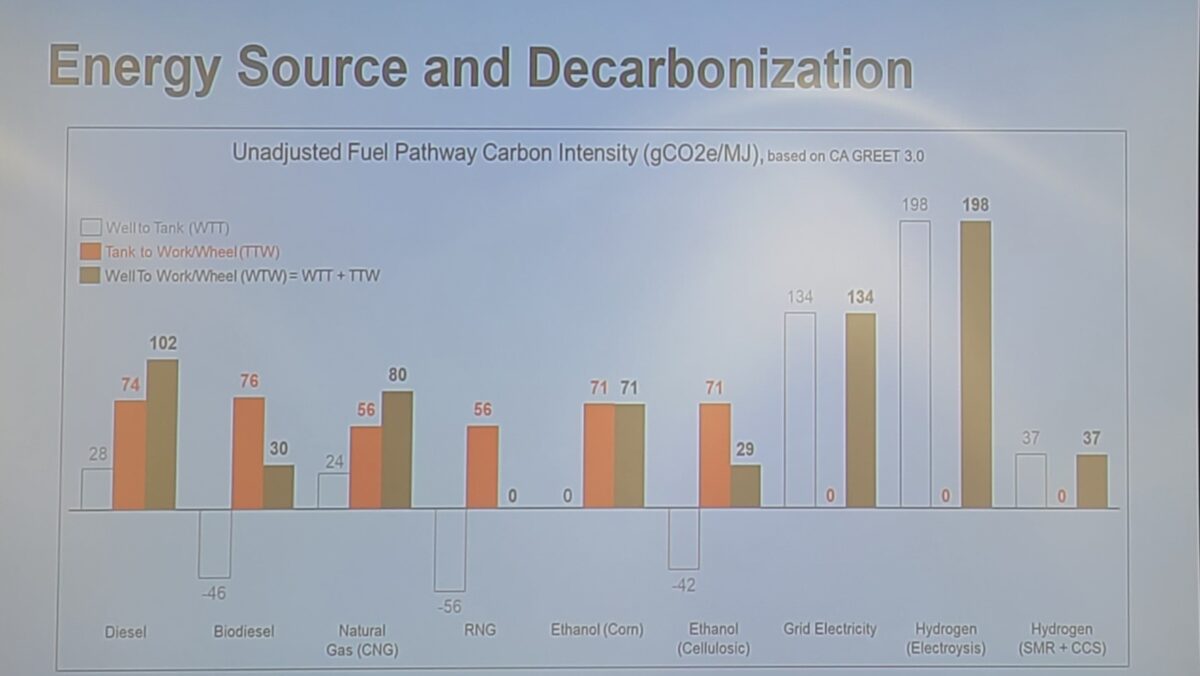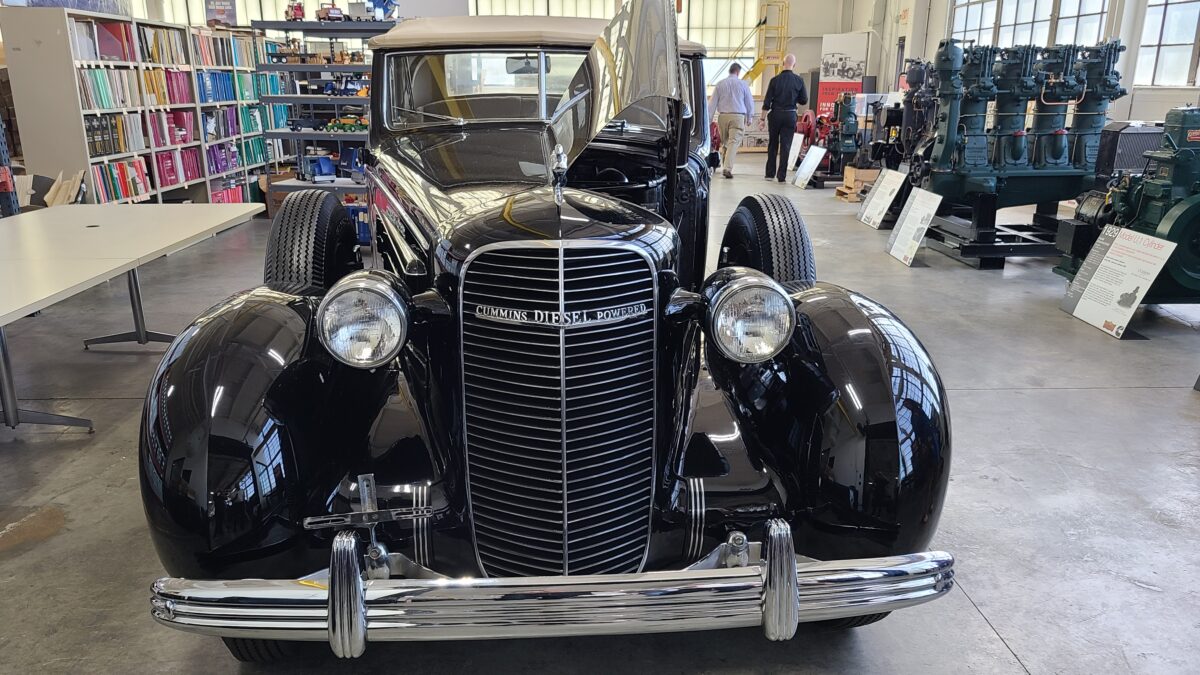Columbus, Indiana, is a Midwest city accessible from two exits on Interstate 65. What goes on there is a century-old enterprise responsible for more diesel engines than anywhere in America. But the home of Cummins Inc. is much more as I found during a two-day visit this week.
Historic intertwining
The midsize Indiana city of Columbus about midway between Indianapolis and Louisville, Kentucky, is a textbook definition of a company town.
The renowned architecture of its downtown buildings, multi-generations of families employed by Cummins Inc. in its first 100 years and a commitment to help save the planet in its second century evince an intertwined history.
The American Institute of Architects lists Columbus sixth in the nation for architectural innovation, trailing only Chicago, New York, San Francisco, Boston and Washington. Listings on the National Register of Historic Places dot the downtown. And six locations are part of the more exclusive National Historic Landmarks Program.
But what you see practically everywhere in the city of 48,000 is the influence Cummins plays. Columbus ranked in the top 2% of manufacturing cities in 2019, according to the Bureau of Labor Statistics, and tops in affordability, education and growth among young professionals, according to the Pew Charitable Trust in 2017. Accolades are too numerous to list.
Thank you, Clessie Cummins, who founded the company in 1919 and oversaw decades of growth until his death in 1968.
Cummins for tomorrow
Tom Linebarger, the current president and CEO, is molding the company for its second century. Efforts to meet and beat toughening emissions regulations for diesel are front and center.
But Cummins deliberately is researching and developing drop-in fuels for its engines — from gasoline to natural gas to propane and hydrogen. The goal is an agnostic strategy aimed at cleaning up the environment from the well to the wheel, not just from the pump to the tank. Battery-electric and hydrogen fuel cells also play a role.

“We think we have solutions in our pocket that can meet more stringent greenhouse gas like our hybrids and range extenders and we’re saying we will be willing to partner to help drive greenhouse gas [reductions] even farther with our portfolio,” said Uma Vajapeyazula, director of Cummins’ engine business unit for on-highway product strategy.
“The fuel has to be clean. You don’t have to bring dramatic new technology to do that. You can actually clean up the grid with renewable fuels. That’s where that magic can happen.”
Cummins’ plan for fuel-agnostic engines
Srikanth Padmanabhan, president of Cummins Engine Business, said fuel-agnostic engines have been in the works at Cummins for 20 years.
“Finally, we’re trying to make it happen,” he said. “Above the head gasket things change. Below the head gasket, things are common.”
Cummins’ next big thing in renewable fuels is a natural gas-powered version of its X15 engine, with power and torque numbers for long haul comparable to diesel. Running petroleum-based natural gas gets 15% to 20% lower carbon emissions.
Renewable natural gas (RNG) could take emissions below zero because of the way dairy waste and other biomass is calculated. In 2021, there were 230 RNG projects across the nation with capacity to produce a total of 574 million diesel-gallon equivalents for transportation, according to the Department of Energy
Cummins is using the same engine block to make an X15 that can use hydrogen as a fuel. This is the kind of future product the company typically wouldn’t talk about until it is much closer to its 2027 production. But with California Air Resources Board and Environmental Protection Agency nitrogen oxide regulations bearing down for 2024 and 2027, Cummins is speaking out.
Werner Enterprises is the first to publicly announce it will test the hydrogen ICE. Another dozen interested fleets have signed nondisclosure agreements. One key benefit: 75% lower NOx emissions than today’s diesel.
This will complement Cummins’ efforts in hydrogen-powered fuel cells. It has more than 2,200 operating around the world, including on trains in Germany.
Technology tour de force
Cummins has so much more in the works at its 500,000-square-foot research and technical center. Mostly built in the 1960s, the tech center shows its age but the work underway is almost pure future stuff.
What you don’t see is a lot of people. Cummins and Columbus took a huge hit from the coronavirus pandemic. Where 1,200 people used to report for work daily, about a third of that number occupy labs and test areas. Cummins never shut down its test cells and it maintained productivity even as a hybrid model of work took hold across the company.
In the advanced materials evaluation lab, outsized computed tomography (CT) scanners probe batteries, fuel injectors and engine catalysts for defects.
With 89 dynamometer test cells running 24/7, Cummins can test performance and durability of engines from 2.8 liters to 19 liters.
A lab for additive manufacturing — also known as 3D printing — creates metal parts for older engines where inventory expected to last the lifetime of a product is exhausted. About 40 part numbers, many for H55 engines used in Toyota and Dodge products in the 1990s and earlier, are available. The coolest swag of the visit was a 3D-printed adjustable wrench. It really works.
Outside the tech center, a new testing complex for high-voltage components literally stands alone. Five testing cells — two each for batteries and traction motors and one for power electronics — arrived in five shipping containers from Advanced Contracting Solutions in Madison, Wisconsin, during the early days of the pandemic.
Cummins prepared the site with concrete slabs and fire suppression systems.
Oh, the heritage
For all the focus on the future, Cummins honors its past.

Like any historic collection, a certain unkemptness is part of the charm. At the Cummins Heritage Center, engines from across the years dominate. One special display — a 1919 Model C 6-horsepower oil-powered engine that predates Clessie Cummins’ diesels — is the best show and tell of the trip. It actually runs.
Watch now: Firing up a piece of history
Getting out the vote
June 30 is a critical date for the future of Nikola Motors. That’s the day the company will reconvene its annual meeting and see if it has enough votes to increase the number of shares in company stock.
The share increase authorization failed to get enough votes at the virtual meeting on June 1 because indicted founder Trevor Milton voted his 11% of the company stock against the proposal.
Nikola wants to increase the number of authorized shares from 600 million to 800 million. That would allow it flexibility to register and sell new shares to raise money it needs to scale the business. Most of its current allocation is or will be in play soon.
Because of Milton’s intransigence — he has to vote in favor of directions but can go his own way on ballot proposals — Nikola is spending precious money to encourage shareholders to vote their proxies in favor of the high number of shares even though it would dilute the value of current shares.
That doesn’t matter much to small investors, but if you hold 11% of the company like Milton does, it is a big deal.
That’s it for this week. Thanks for reading. Truck Tech is taking a week off and will return on Friday, July 1. Click here to get Truck Tech in your email on Fridays.
Thanks, Alan
Correction: The June 10 Truck Tech incorrectly said the Hyzon Motors retrofitted Freightliner Cascadia fuel cell truck was running 400 miles from Long Beach to Sacramento, California. The test vehicle was used by Total Transportation Services Inc. in and around the Port of Long Beach.











